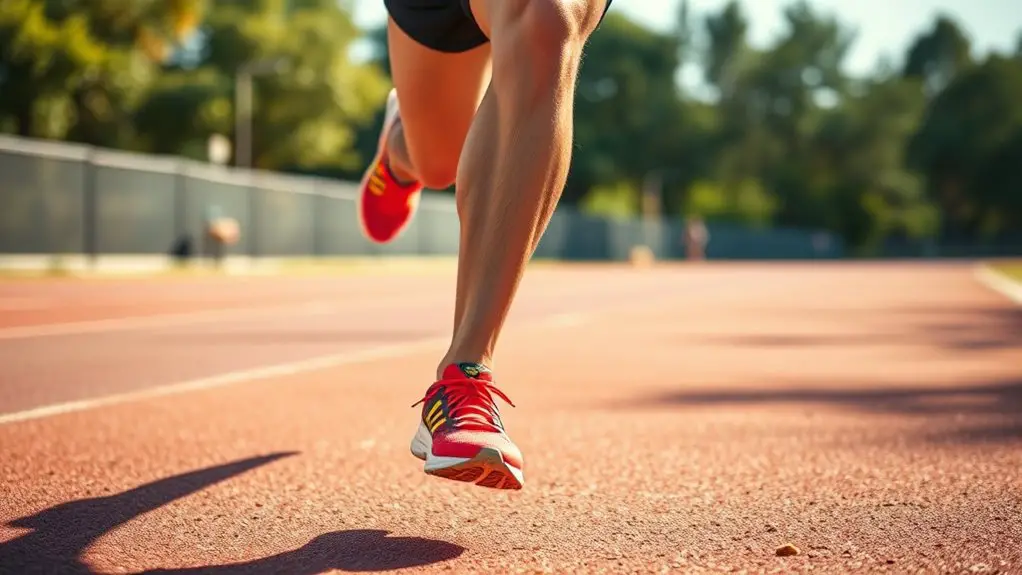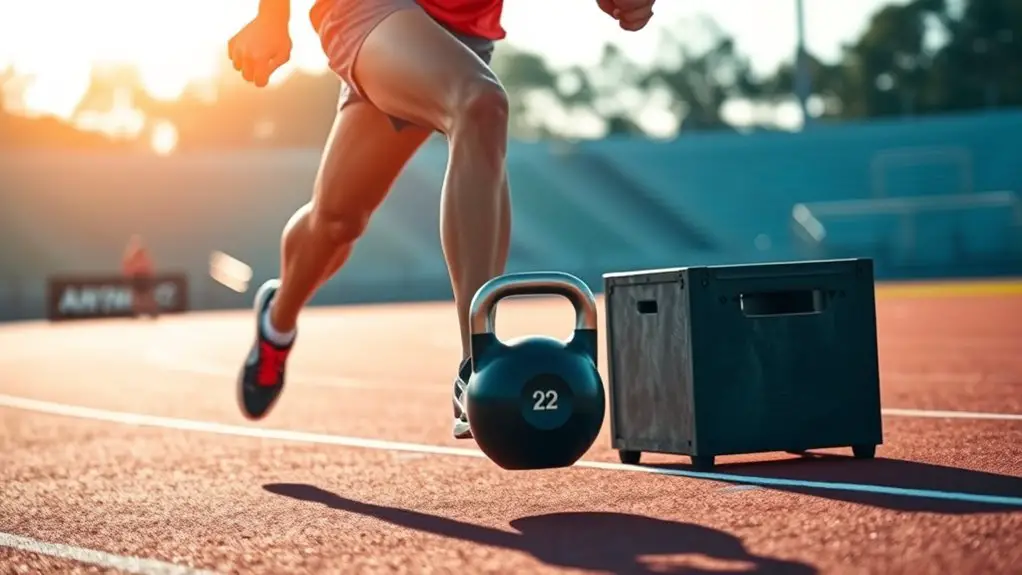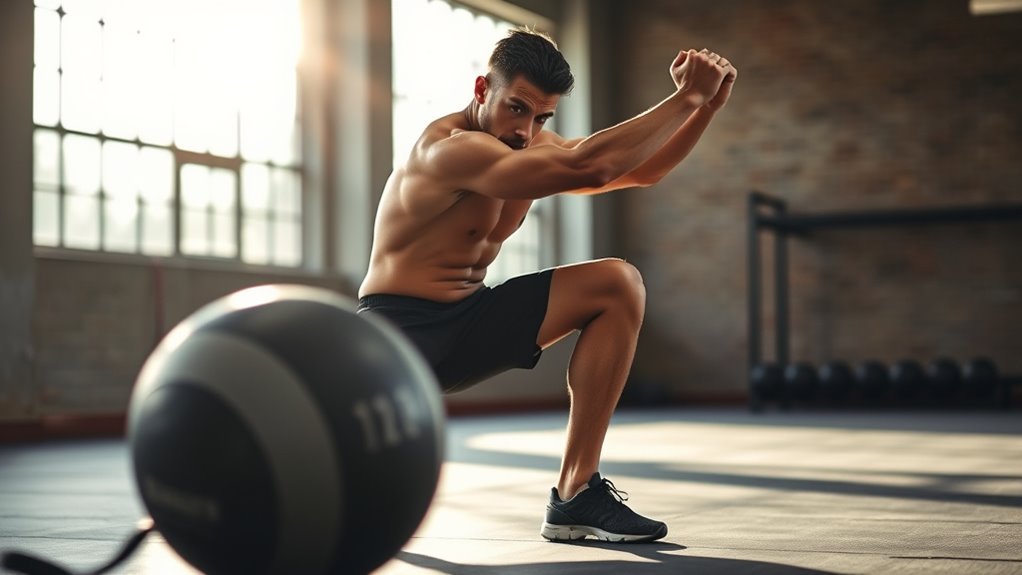Strengthening your legs is essential for improving running speed. Focus on key muscle groups like your quadriceps, hamstrings, and calves. Incorporate exercises such as squats, lunges, and plyometric drills to enhance power and explosiveness. Core stability also plays an important role in your overall performance. Don't forget to stretch regularly for flexibility and recovery. Want to optimize your training further? Keep going to explore more effective strategies and tips for leg strength and speed enhancement.
The Importance of Leg Strength for Runners
When you consider improving your running speed, leg strength often plays an essential role. Strong legs not only help you push off with power but also enhance your running mechanics, allowing you to move efficiently and freely. To achieve this, investing in proper footwear is vital. The right shoes provide the support and cushioning your legs need, preventing injuries and optimizing your performance.
As you focus on leg strength, remember that it's about balance and coordination, not just brute force. Strengthening your quads, hamstrings, and calves can lead to longer strides and quicker recovery times. Incorporating exercises like squats and lunges into your routine can make a world of difference. Exercises such as squats and lunges are not only beneficial for runners but also enhance overall stability and endurance. By honing your leg strength, you're not just running faster; you're embracing the freedom of movement that comes with being a strong, capable runner. So, lace up those shoes, and let your legs carry you toward your goals!
Key Muscle Groups to Target
To boost your running speed, it's essential to focus on key muscle groups. Strengthening your quadriceps and hamstrings will enhance your power and stability, while developing your calf muscles can improve your push-off and overall speed. Incorporating plyometric exercises into your routine can further enhance explosiveness and leg power. Let's explore effective techniques to target these areas.
Quadriceps and Hamstrings Strengthening
Strengthening your quadriceps and hamstrings is crucial for enhancing running speed, as these muscle groups play an essential role in leg power and stability. By incorporating effective quadriceps exercises into your routine, you'll build the strength necessary for powerful strides. Think squats, lunges, and leg presses—these movements will help you release your potential.
Don't forget the importance of hamstrings stretches to improve flexibility and prevent injuries. Simple stretches like standing hamstring stretches or seated toe touches can keep your muscles limber and ready for action.
Calf Muscles Development Techniques
The calf muscles, primarily the gastrocnemius and soleus, are essential for running speed and efficiency. To develop these muscles effectively, you can incorporate a few techniques into your routine:
- Calf Raises: Stand on the edge of a step and raise your heels, letting your calves stretch before lifting again. This targets both muscle groups.
- Resistance Bands: Use bands for calf exercises to add resistance, enhancing strength and endurance. Anchor the band and perform plantar flexion for maximum effect.
- Single-Leg Variations: Challenge your balance and strength by performing calf raises on one leg, which also engages stabilizing muscles.
Effective Strength Training Exercises
While many runners focus solely on mileage to boost their speed, incorporating effective strength training exercises can make a significant difference in performance. To free yourself from limitations, consider integrating bodyweight exercises and resistance training into your routine.
Start with squats and lunges; they'll strengthen your quads and glutes while improving balance. Push-ups can enhance your core stability, which is essential for maintaining proper running form. Resistance bands are fantastic tools for adding variety; exercises like banded leg extensions and lateral walks target your hip muscles, promoting a more powerful stride.
Don't forget about your calves—calf raises can be done anywhere, providing that extra boost you need. Aim for two to three strength sessions a week to build endurance and power. By embracing these exercises, you're not just running; you're paving the way to speed and freedom on the track. Additionally, incorporating squats and lunges can enhance your overall athletic performance, contributing to a more efficient running technique.
Incorporating Plyometrics Into Your Routine
If you want to take your running to the next level, incorporating plyometrics into your routine can be a game-changer. Plyometric drills are all about explosive movements that build strength, speed, and agility. By adding these dynamic exercises, you'll enhance your leg power and improve your overall performance.
Incorporate plyometrics to elevate your running, boosting strength, speed, and agility for peak performance.
Consider integrating these plyometric drills into your workouts:
- Box Jumps: Boost your vertical leap and strengthen your legs with this explosive movement.
- Jump Squats: Combine squats with jumps for a powerful lower body workout that mimics the running motion.
- Lateral Bounds: Improve your side-to-side agility, which is essential for maintaining balance and speed.
As you commit to these drills, you'll notice increased muscle activation and faster running times. Additionally, focusing on functional strength through these explosive exercises can lead to significant improvements in your athletic performance. Embrace the freedom of movement and let plyometrics propel you toward your running goals!
The Role of Core Strength in Running
When you think about running speed, don't overlook your core strength. A stable core not only supports your posture but also enhances your running efficiency, allowing you to cover more ground with less effort. By strengthening your core, you can improve your overall performance and speed on the track. Additionally, a strong core reduces injury risk, enabling you to maintain a consistent training regimen and push your limits.
Core Stability Benefits
Core stability plays an essential role in running performance, as it helps maintain proper posture and balance throughout your stride. When you focus on core activation, you're not just strengthening your abs; you're also enhancing your overall running experience. Here are some key benefits of core stability:
- Improved Posture: A strong core keeps your torso aligned, reducing unnecessary strain on your legs.
- Enhanced Balance: Balance training reinforces stability, allowing you to navigate uneven terrains with confidence.
- Injury Prevention: A stable core helps absorb shock, minimizing the risk of injury from repetitive impacts.
Enhanced Running Efficiency
While many runners focus solely on leg strength to boost their speed, neglecting core strength can hinder overall efficiency. A strong core supports better running form, allowing you to maintain ideal posture and reduce fatigue. This leads to improved muscle endurance, enabling you to run longer and faster with less effort.
| Core Exercise | Benefits | Recommended Reps |
|---|---|---|
| Planks | Enhances stability | 3 sets of 30 sec |
| Russian Twists | Increases rotational power | 3 sets of 15 |
| Bicycle Crunches | Boosts core engagement | 3 sets of 20 |
| Side Leg Raises | Strengthens hip abductors | 3 sets of 15 each side |
Incorporating core training into your routine can free you to reach new running heights.
Designing a Balanced Strength Training Program
To enhance your running speed, it is essential to design a balanced strength training program that targets all major muscle groups in your legs. This guarantees you're not just strong, but also functional and resilient. Incorporate exercise variations to keep your workouts fresh and engaging. Consider implementing strength periodization to maximize your progress over time.
Design a balanced strength training program to target all leg muscles, ensuring strength, functionality, and resilience for improved running speed.
- Focus on compound movements like squats and deadlifts for overall strength.
- Include unilateral exercises, such as lunges, to address muscle imbalances.
- Don't forget to add plyometric drills to develop explosive power. Additionally, prioritize core stability to improve your overall performance and reduce injury risk.
Sample Leg Workout for Runners
To boost your running speed, incorporating essential leg exercises into your routine is key. You'll want to contemplate how often you should work out and don't forget the importance of stretching for flexibility. Let's break down a sample leg workout that can help you achieve your running goals. Additionally, focusing on muscular endurance can significantly enhance your leg strength and overall running performance.
Essential Leg Exercises
Incorporating the right leg exercises into your routine can considerably enhance your running speed and overall performance. Start with dynamic warm ups to prepare your muscles, then include these essential leg exercises for peak strength:
- Squats: Great for building overall leg power and stability.
- Lunges: Target quads and hamstrings while improving balance.
- Resistance Band Exercises: Use bands to strengthen hip flexors and glutes for better propulsion.
These exercises not only boost your strength but also increase your endurance and speed. Remember, consistency is key, so make these a regular part of your training. By focusing on these essential leg exercises, you'll feel the freedom to run faster and longer, enjoying every stride you take.
Workout Frequency Recommendations
While establishing a workout frequency for leg strength, it's important to balance intensity and recovery to maximize your running performance. Aim for two to three leg workouts per week, focusing on varying workout intensity. On days you push hard, prioritize exercises like squats and lunges, while reserving lighter sessions for mobility and endurance drills.
Stretching for Flexibility
Maximizing leg strength workouts not only improves power but also enhances flexibility, which is essential for runners. To boost your flexibility, integrate both dynamic and static stretching into your routine. Here's a quick guide:
- Dynamic stretching: Perform leg swings and walking lunges to warm up your muscles before a run.
- Static stretching: After your run, target major muscle groups like hamstrings and quadriceps with stretches held for 15-30 seconds.
- Consistency: Make stretching a regular part of your training, ideally 3-4 times a week.
Recovery and Injury Prevention Strategies
To guarantee you stay injury-free and recover effectively, it's vital to implement a well-rounded strategy that includes rest, proper nutrition, and targeted exercises. Incorporating active recovery days into your routine can work wonders; light activities like walking or cycling help maintain blood flow and reduce muscle soreness. Listen to your body—if you're feeling fatigued or sore, that's your cue to take a break.
Injury management is significant for any runner aiming to improve speed. Pay attention to any signs of discomfort and address them early. Regular stretching and strength training not only enhance leg strength but also promote flexibility, reducing the risk of injury. Make sure you're also committing time to foam rolling or massage, which can alleviate tension and enhance recovery. Additionally, incorporating proper warm-up techniques before your workouts can further minimize the risk of hamstring injuries. Embrace these strategies, and you'll not only run faster but also enjoy the journey without the setbacks of injury.
Nutrition to Support Leg Strength
Recovery and injury prevention are only part of the equation when it comes to improving your running speed. Nutrition plays a crucial role in supporting leg strength. To enhance your performance, focus on these essential components:
- Protein Sources: Incorporate lean meats, legumes, and dairy to repair and build muscle.
- Hydration Strategies: Stay hydrated before, during, and after runs to maintain peak performance.
- Nutrient Timing: Consume pre-workout snacks like bananas or oatmeal for energy, and post-workout meals rich in healthy fats and carbohydrates for recovery. Proper nourishment aids in muscle repair and replenishing energy stores.
Meal planning can help you balance your mineral intake and vitamin supplements, ensuring you're fueling your body right. Don't forget about carbohydrate loading before long runs to maximize energy stores. Embrace these strategies, and you'll not only strengthen your legs but also access your running potential.
Tracking Progress and Setting Goals
Setting clear goals and tracking your progress are essential steps in enhancing your running speed. You've got to know where you want to go before you can get there. Start by setting specific, measurable goals—like improving your mile time or increasing your distance. Write them down and keep them visible; this keeps you motivated and accountable.
Next, embrace progress tracking. Use a running app or a simple journal to log your workouts, noting distances, times, and how you felt. This'll help you see patterns and celebrate your improvements, big or small. If you hit a plateau, reassess your goals and adjust your training plan. Remember, it's all about the journey. Embrace the freedom that comes with knowing you're actively working towards your goals. With consistent progress tracking and intentional goal setting, you'll find yourself running faster and feeling more accomplished than ever.
Frequently Asked Questions
How Often Should I Strength Train for Optimal Running Performance?
When it comes to strength training frequency, you should aim for about two to three sessions per week for peak running performance. This balance allows your muscles to strengthen while also ensuring ideal recovery. Listen to your body; if you feel fatigued, it's okay to take an extra day off. Remember, it's not just about pushing hard, but also about giving yourself the freedom to recover and enjoy the process.
Can I Strengthen My Legs Without Going to the Gym?
Think of your body as a tree, growing stronger with each passing season. You don't need a gym to cultivate your roots; bodyweight exercises can help you build strength right in your backyard. Outdoor workouts, like squats and lunges, let you connect with nature while enhancing your leg muscles. So, grab your gear or just use your body weight—freedom to train anywhere is the key to flourishing like that tree!
What Are the Signs of Overtraining My Leg Muscles?
If you're wondering about the signs of overtraining your leg muscles, look out for fatigue indicators like persistent soreness, decreased performance, or increased injuries. You might also notice mood changes or trouble sleeping. To combat this, consider incorporating recovery techniques such as proper rest, hydration, and gentle stretching. Remember, it's all about finding balance and listening to your body so you can keep enjoying your freedom in movement without unnecessary setbacks.
Should I Stretch Before or After Strength Training Workouts?
You might wonder whether to stretch before or after strength training workouts. It's often best to incorporate dynamic stretching before your session to warm up your muscles and enhance flexibility. This can help prevent injuries and improve your performance. After your workout, static stretching is great for cooling down and promoting recovery. So, embrace both types of stretching to keep your body feeling free and ready for whatever comes next!
How Does Hydration Affect Leg Strength and Running Speed?
Imagine running a marathon under a blazing sun, feeling like a ship adrift without water. Hydration's benefits are your lifeline, keeping your muscles fueled and your joints lubricated. When you're well-hydrated, you maintain electrolyte balance, essential for muscle function. Dehydration can sap your strength and slow you down. So, grab that water bottle and embrace hydration—it's your ticket to feeling free and powerful on the track!




